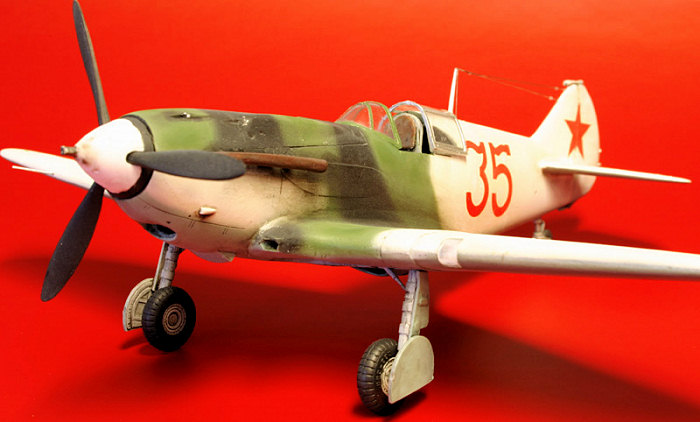
South Front 1/48 LaGG-3 (series 3/4)
| KIT #: | 48001 |
| PRICE: | € 27.00 (currently about $35.00) |
| DECALS: | Five options |
| REVIEWER: | Pierre-André Boillat |
| NOTES: | First effort of a new Russian company |

| HISTORY |
Based
on the I-22 fighter prototype, the LaGG-1 was the brainchild of the design team
formed in 1938 by Semion Alexeievich Lavochkin, Wladimir Petrovich Gorbunov and
Mikhaïl Iwanovich Gudkov (short: LaGG). To avoid a waste of strategic light
metals, most of the new fighter’s structure and skin was made of wood and “shpon”,
a wood-bakelite composite previously used on the Polikarpov I-16. After the
LaGG-1’s first flight in 1940, the type was soon improved with a with an M-105PF
engine of 1210 HP and l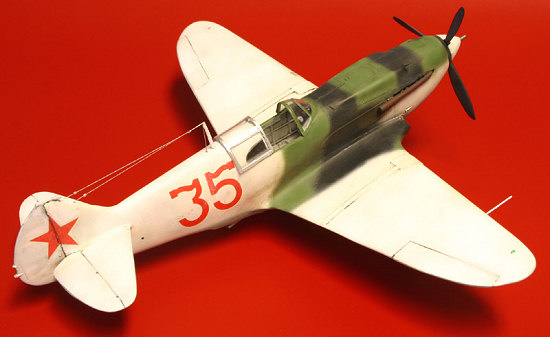 arger
fuel tanks, and entered service as the LaGG-3 in 1941, 300 aircraft (mainly of
the 4th series) being ready at the time of operation “Barbarossa”.
arger
fuel tanks, and entered service as the LaGG-3 in 1941, 300 aircraft (mainly of
the 4th series) being ready at the time of operation “Barbarossa”.
Unfortunately, the chaos caused by the evacuation of most soviet aircraft factories beyond the Ural and the use of untrained workers caused a sensible drop in both production and quality, many early LaGG-3s that reached the front lines turning out as unusable.
Further improvements were made as production batches went (the last batch, “66th series”, entering service in summer 1942), but the even the best LaGG-3s were only as good as its more successful “comrade”, the Yak-1.
Heavy and under-motorized, the LaGG-3 was never popular with its pilots (one of the aircraft’s nicknames was “varnished, guaranteed coffin”) in spite of its outstanding sturdiness, because of poor reliability and sub-standard performance compared to the German opposition, and it was withdrawn from first-line duties as soon as better types such as the vastly superior LaGG-5 went into production. However, during the first 18 months of the “Great Patriotic War”, it was one of the USSR’s most important fighters, and its greatest quality was to be available in large numbers in a time of bitter need. A total of 6’258 LaGG-3s were built.
| THE KIT |
nice for a first try, but…
I
found this kit in a French model shop this summer, and it came as a complete
surprise, as I had never heard of this company. South Front is a new
manufacturer from Russia, and the LaGG-3 – 4th series (followed by an
early “razorback” La-5) is their first
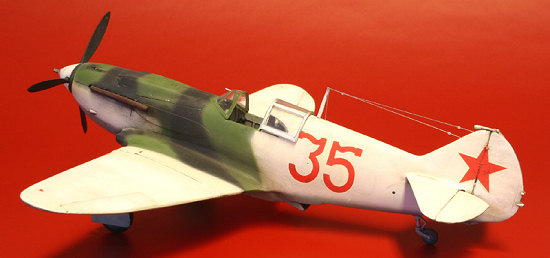 effort – and a welcome one, if
you consider that this important soviet fighter has been kitted only three times
in 1/48: one in the early 90’s by LTD Models (not a very good one, but that has
reached collector status since the brand’s early demise after only four kits),
and a 2007 state-of-the-art resin model by Vector, which is as beautiful as it
is expensive. In this regard, the South Front kit is a welcome sight.
effort – and a welcome one, if
you consider that this important soviet fighter has been kitted only three times
in 1/48: one in the early 90’s by LTD Models (not a very good one, but that has
reached collector status since the brand’s early demise after only four kits),
and a 2007 state-of-the-art resin model by Vector, which is as beautiful as it
is expensive. In this regard, the South Front kit is a welcome sight.
However, every first production usually has its shortcomings… Let’s have a closer look:
The soft, not-so-well illustrated box (but it’s a matter of taste) contains two sprues of soft, white plastic, a set of transparencies, two separate wheel hubs and a pair of rubber tyres (of which I hope they aren’t of the “styrene-dissolving type”). Plastic wheels are also included, but they don’t look half as nice – so I took the risk and picked the rubber ones.
All instructions are in Russian only, but except if you really want to read the historical part, the construction drawings and colour profiles on the back of the box are more than enough to complete the project.
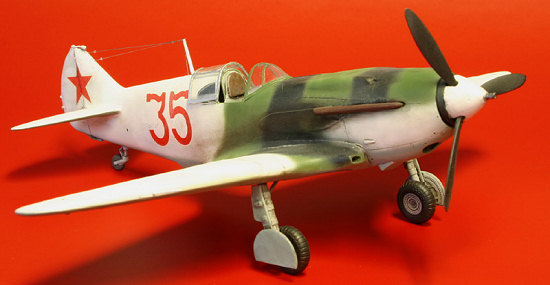 On my issue, the transparencies
were less than good (the plastic was sort of grainy) - just roughly acceptable.
As most early LaGG-3s flew without a canopy (due to the fact that the latter
could not be jettisoned in an emergency), many modellers will chose to do
without and just keep the windshield and side windows. The version I chose had
the canopy on, so I kept it, making things look a little better with a coat of
Future.
On my issue, the transparencies
were less than good (the plastic was sort of grainy) - just roughly acceptable.
As most early LaGG-3s flew without a canopy (due to the fact that the latter
could not be jettisoned in an emergency), many modellers will chose to do
without and just keep the windshield and side windows. The version I chose had
the canopy on, so I kept it, making things look a little better with a coat of
Future.
Due to the poor quality of the styrene (or cheap injection machinery), the parts present a large amount of flash. But this is not so bad, because at least the panel lines are finely engraved. You just have to be ready for some parts-cleaning. The wing trailing edges are thick, a problem more patient modellers will want to correct. I didn’t. All in all, I’d say it’s short-run, and it shows.
The decals (for 5 different machines in summer and winter camo) are in perfect register, and the colours are OK.
| CONSTRUCTION |
The LaGG’s
assembly is not the proverbial piece of cake. The cockpit is detailed enough
for my taste (with structured side-walls, a decent seat and its armoured
back-plates, a (rather crude) stick, rudder pedals, and a pretty good
instruments panel that can be covered with a decal (I did so using decal softer,
and the instruments settled in their cavities OK). As with most Lavochkin
aircraft 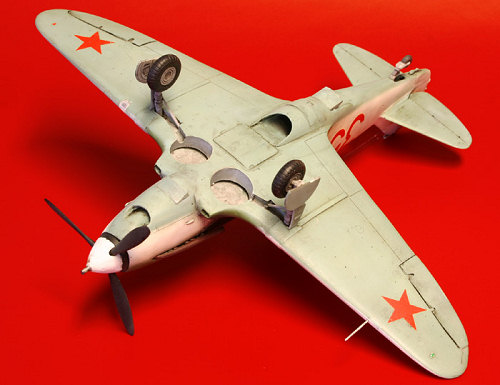 kits, the rudder
pedals are installed on the wing’s center-section, which is also the cockpit
floor. All interior parts come in a very light grey, according to my
documentation. All this may seem a little Spartan, but so were early soviet
aircraft, too.
kits, the rudder
pedals are installed on the wing’s center-section, which is also the cockpit
floor. All interior parts come in a very light grey, according to my
documentation. All this may seem a little Spartan, but so were early soviet
aircraft, too.
The next difficulty comes from the various air intakes in the fuselage. They are detailed enough so you don’t have gaping “see-through” holes in you model, but their fit is so poor that you’ll have to putty and sand inside them… and I guess you know how hard it is!
Further, the wing-fuselage assembly (with the joint going half-way up the fuselage) would have been a strike of genius on a better-engineered kit, but on this one, you’ll have to use further putty and a lot of sanding paper, especially where the wing meets the radiator.
In general, the parts’ fit is a bit tricky, and the plastic melts too much under the glue, drying very slowly.
All in all, once the airframe’s assembled, you’ll have to systematically fill all the joints, and give it an energetic sanding job. After this was done – along with a first coat of primer, things started to look much better.
| COLORS & MARKINGS |
Being
satisfied with the look of the airframe’s surfaces (thanks to the LaGG’s wooden
construction, there are not many panel lines to re-engrave after the sanding), I
could go to the painting job. As said above, the kit offers five versions: two
in olive and black  summer camo,
one, “red 46”, in overall white (although experts argue if this particular
machine wasn’t overall silver – an opinion I tend to share according to the pics),
one in a very faded winter camo, and lastly my choice, “red 35”, a machine of
the 3rd Guards Fighter Regiment (GvIAP) of the Baltic Fleet, flown by
Sen. Lieutenant Georgi Dimitrievich Kostilov in winter 1942.
summer camo,
one, “red 46”, in overall white (although experts argue if this particular
machine wasn’t overall silver – an opinion I tend to share according to the pics),
one in a very faded winter camo, and lastly my choice, “red 35”, a machine of
the 3rd Guards Fighter Regiment (GvIAP) of the Baltic Fleet, flown by
Sen. Lieutenant Georgi Dimitrievich Kostilov in winter 1942.
At the time when this aircraft’s pictures were taken, it had a clean and freshly-applied white winter camouflage covering all upper surfaces except for the cowling, the fuselage sides to the mid-cockpit, and the wing roots which were left in olive green and black. The scheme was airbrushed and sealed, and the decals were applied. These are of fairly good quality, but the film they’re printed on is a little yellowish – and this will show on the white paint. I used softening solution, but this would have not been necessary, and on some spots even damaged the decal. Afterwards, I applied the usual weathering (diluted oil paints).
| FINAL CONSTRUCTION |
As usual, I added
the landing gear, prop and transparent parts, the latter’s framing being made of
painted decal stripes. The side windows had to be sanded to fit a little, but it
was no big deal. The kit comes with a set of rocket rails (with no rockets,
though), but 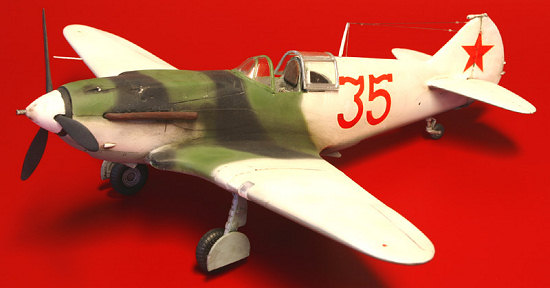 I chose not to
install them, as I prefer the LaGG in “clean” configuration. A little
post-shading with the airbrush, a few brushed white retouches to add realism
(and hide that yellow area around the decals), a final coat of matt, exhaust
stains made of pastel powder, the antenna wires, and here you go: another
finished project joins the collection.
I chose not to
install them, as I prefer the LaGG in “clean” configuration. A little
post-shading with the airbrush, a few brushed white retouches to add realism
(and hide that yellow area around the decals), a final coat of matt, exhaust
stains made of pastel powder, the antenna wires, and here you go: another
finished project joins the collection.
| CONCLUSIONS |
At the end of the day, I’m pretty pleased with this kit. Granted, the price is a little high for what you actually get, it’s far from the quality we’re used to with products from the major manufacturers, it’s more likely to become a “three-footer” than a contest-winning bird, but given the type’s appeal and historical importance (at least for me – for some reason, a LaGG-3 has been one of my pet projects for years), I was more than willing to make the extra effort. Rating: recommended to all fans of soviet aircraft who have built a few short-run kits before.
| REFERENCES |
“Mach 1” – Encyclopédie de l’Aviation, Editions Atlas.
LaGG fighters in Action – Squadron Signal # 163
Various internet research.
November 2007
Copyright ModelingMadness.com. All rights reserved. No reproduction in part or in whole without express permission.
If you would like your product reviewed fairly and fairly quickly, please contact the editor or see other details in the Note to Contributors.